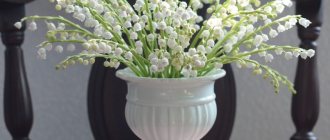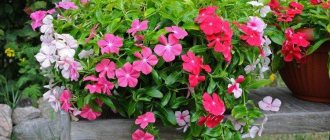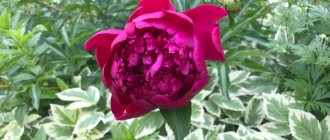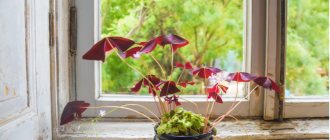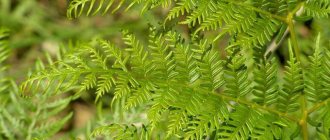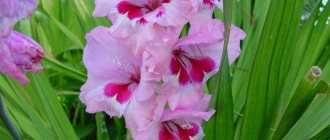Short description
Despite serious differences in size, cycles, even life forms (there are herbaceous and woody species), the external characteristics of the species are similar. Let's say more - ferns are the largest group of spores. Ecological plasticity, resistance to excessive watering, unique leaf shape... What other characteristics allow you to recognize a fern among hundreds of other plants?
Fern
- Planting fern, a perennial herbaceous shrub, is practiced everywhere. The appearance of the plant is compared to the tail of a capercaillie during the mating season - so fluffy and large.
- Some species do not grow higher than 30 cm. But there are also real giants up to 150 cm high.
- The root system is medium-sized, branched.
- The stem is dense.
- Many call primitive plates foliage, although in fact they are fronds. They are formed from buds located closer to the root.
- One of the common types of reproduction is by spores. They ripen directly on the plates.
Now that we’re done with the short description, we can move on to plant varieties.
Blechnum spicant
A beautiful fern from 30 to 80 cm in height with narrow, fairly dense fronds of silver-green color. One of the rare ferns that has spore-bearing and non-spore-bearing leaves collected in one rosette. The rosette is formed by barren once-pinnate and overwintering leaves, bizarrely lying to the ground and forming tangled ornamental patterns.
Derbyanka is able to settle only on calcareous soils with a sufficient degree of moisture. Prefers partial shade.
Spica weed (Blechnum spicant). © roovershof
One of the ferns that can be used not only to decorate flower beds, but also in ridges, rock gardens, in the design of dry walls or other compositions with rocky soils.
Types of garden ferns
Since not every fern grows at home, you need to take a responsible approach to choosing a specific species. If this is not done, the crop you planted will grow poorly or even die.
For decorative purposes, plant the following types of plants:
- Woodsia. Low-growing appearance. In nature, it is found on rocky slopes and in abandoned buildings. The bushes are small, up to 20 cm. Perfect for decorating a rock garden. The perennial will delight you with its lush greenery for about 15-20 years.
Woodsia - Kochedyzhnik. Some specimens grow up to 1 meter. The greenery is renewed regularly.
- Asplenium. Despite its heat-loving nature, asplenium has taken root well in the central regions of Russia. The best place is considered to be partial shade, in which it grows quite quickly, and wonderful “leaves” appear from medium-sized rosettes. The plant remains so attractive from April until late autumn.
- Bracken. Meet - this is the most common species growing all over the world. Its trifoliate leaves perfectly protect the bulbous flowers in early spring. Subject to all growing conditions, rapid growth and extraordinary splendor of the bush are guaranteed. Some gardeners even build additional fencing to prevent bracken from spreading throughout the garden.
Orlyak - Chistoust. Another species that will become a worthy specimen for your site. The plant is large and has a luxurious crown. It is advisable to plant in damp places.
Fern Chistoust - And one more species that is loved by many summer residents because of its unpretentiousness is the bladderwort. Looks great in alpine hills, but with partial shade.
Common ostrich (Matteuccia struthiopteris)
Fern with a height of 80 to 130 cm, one of the most beautiful and largest. It is famous for its almost straight, evenly symmetrical leaves and light green color. Watching the wide fronds of this fern unfold is a pleasure.
Ostriches prefer semi-shaded locations and moist soil, have a creeping rhizome and tend to spread independently.
Common ostrich (Matteuccia struthiopteris) in a flower garden. © Cathy
It is no coincidence that this fern has won the title of classic and most universal. Noble, filigree, not too large and quite bright in color, the ostrich offers to introduce the beautiful greenery of ancient garden favorites into compositions with herbaceous perennials. The ostrich plant can be an ideal partner not only for the most popular flowering plants, but also for large flowering shrubs or very large perennials with huge leaves (for example, Rogers).
Three methods of reproduction. Which to choose?
The key feature of the fern is that it never blooms at all. You won’t be able to collect seeds from it either - they simply don’t exist. Reproduction occurs only in two ways: with the help of spores and vegetatively. Let's look at them in more detail.
Controversy
Most summer residents choose this method. It may seem complicated to some, but the efficiency is excellent. To collect planting material, we go to the forest, ask neighbors or buy from a garden store:
- Spore harvesting is carried out in the spring. You need to examine the back of the leaf and find small dark tubercles.
- The leaf plates are cut off and placed in a paper bag until the foliage is completely dry.
- With the onset of cold weather, we select brown tubercles from the bag and prepare a place for planting. Small containers with drainage and a standard mixture of humus, peat, and sand are suitable.
- There is no need to water the boxes - just moisten the soil for the fern. The collected pollen is scattered over the surface and sprayed again. To create a greenhouse effect, you need to moisten and wrap the box in a bag.
Fern Ostrich - Don't worry if you don't see any sprouts in the first weeks after planting. Usually shoots appear only after a month. Every day we lightly moisten the soil and admire the seedlings, which resemble a carpet of moss.
- As soon as the male and female sprouts begin to connect, they are transplanted into a separate larger container. Grow until spring warmth arrives and the soil warms up thoroughly.
Dividing the bush
Let's try to figure out how to plant a fern by dividing the bush. Note that only certain plant species reproduce in this way. For example, bracken and fern. As soon as the temperature reaches above zero after winter, you need to:
- Choose strong blanks with dense rosettes. You don’t have to go into the forest - you can ask your neighbors.
- Carefully dig up the bush along with the rhizome. Be extremely careful and careful not to damage the roots.
- Returning home, rinse the plant in warm water and divide it into several parts so that 3-4 buds remain in each.
- All that remains is to plant the preparations in the garden bed. We advise you not to delay the transfer. If the roots dry out, not all plants will be able to take root.
Root layering
Some ferns grow small tendrils along with their leaves. A striking example is Nephrolepis sublime. If there are root cuttings, they can also be used for propagation.
- So, how to plant root cuttings correctly? In early spring, they are placed in a small trench and small cuts are made from below.
- Water it with water, but fertilize it only after the sprouts appear. This can be wood ash, complex fertilizer.
- We dig up a place with a cut tendril and disconnect it from the mother bush. This simple action will provoke rapid growth of the root system.
- When constant warmth is established, the sprouts are planted in a permanent place.
Of course, planting ferns in the country can also be done by budding. However, this method takes a long time, is quite complex and is applicable only to a few species. The buds are cut off and planted in sphagnum moss.
Polystichum setiferum
A large and quite variable fern, which in favorable conditions can reach a meter in height. The leaves are dark green, filigree, dense, with a clearly visible sorus and a toothed-bristle edge, wide, most often curved in arcs and spreading. The rosette seems sloppy, but very elegant.
Despite its shade-loving nature, the multi-row plant is not at all afraid of the sun. This fern prefers light soils with high nutritional value.
Polystichum setiferum. © phengels
The fern can become an aerial partner for absolutely any beautifully flowering herbaceous perennial, especially for summer-flowering species. Modest in any other place, this fern gives the impression of being somewhat sloppy, loose, it slightly creeps into the territory of flowering plants, while creating a surprisingly harmonious contrast and giving airy lightness to profusely colored ensembles.
Necessary conditions for planting
In order for a young bush to grow and develop, it needs to be provided with appropriate conditions.
- Illumination. The best way to grow and care for ferns is when the plants are planted in a bed with partial shade. Under the canopy of a large deciduous tree, seedlings will also grow well. This also applies to the northern side of outbuildings.
- Wind. Drafts and strong gusts of wind pose a real threat to the plant.
Fern on the site - Humidity. It's good if there is a shaded pond or pool nearby. This environment is comfortable, since it is much easier to grow ferns in a humid environment.
- Overall, it thrives in most standard soil types. The exception is heavy soils and wetlands - you definitely can’t do without drainage from broken bricks or expanded clay.
- When a fern is planted in a country house, planting and care are always accompanied by the construction of an additional fence. For this you can use boards or sheets of slate. The fact is that the bushes almost instantly fill the entire flower garden. And if low-growing flowers grow nearby, the fern will begin to oppress them.
Features of caring for adult plants
Even beginners can cope with this simple task. However, you will still have to study the basic rules of planting and care in the open ground.
- Watering, loosening. The main condition for stable growth and density of the bush is timely watering. It is extremely important that the root system receives enough water and oxygen. In the first days of growth, the soil is moistened daily, then watered only during the dry period.
Fern in a flower pot
Periodically replenish the layer of mulch from peat and sawdust, sunflower husks. And if you sprinkle a few spruce needles under each bush, the garden will be filled with a pleasant, almost fairy-tale atmosphere. - Feeding and renewal. Fertilizing is a vital part of caring for ferns in the garden. During active growth, plants are sprayed with complex fertilizers with a growth enhancer, and at the end of autumn they are treated with copper sulfate. And the tree trunk space is covered with ash. So the answer to how to feed the fern is obvious.
- A two-year-old fern does not yet need replanting if the plant is healthy and the location is chosen correctly. But you can remove all old leaf plates, damaged or weak areas. With the help of pruning in the garden, the plant is rejuvenated, material is prepared for further planting and care.

